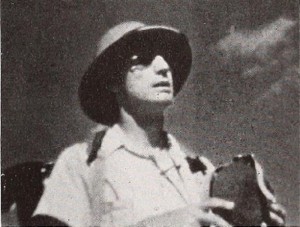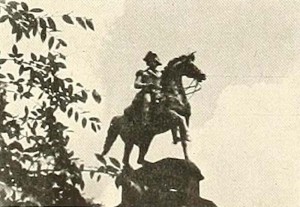
"Rainbow Fantasy, in the words of Charles C. Hammack, is "an attempt to produce — not a conventional travelog — but more a story of adventure, a hiking adventure to what is probably one of the least visited of our national monuments, Rainbow Bridge, in southeastern Utah." In achieving this goal, Mr. Hammack has been largely and creditably successful. For him and his young wife, Rainbow Bridge takes on the aura of a lost horizon, a Shangri La protected from the outside world by the blistering desert heat and the brutal desert rocks. He brings this overtone of feeling to his film, both through his imaginative camera treatment of the subject and the intentionally dramatic acting of the two travelers. Mr. Hammack's is a new name in Ten Best competition, but it is one which we believe will be heard again."Movie Makers, Dec. 1943, 478.
"Ramblings Around Sydney, by James A. Sherlock, ACL, is a carefully planned and photographed motion picture study of a city, a happy example of what care and cinematic sensitivity can do for this type of subject. Although Mr. Sherlock did not commit himself to any strong continuity theme, the picture yet has a delicate cohesiveness that defied the best efforts of the earlier amateur movie makers. Outstanding are the filter shots, the shots made of city streets in the rain and the night scenes. Throughout there is a careful choice of camera viewpoint which succeeds in revealing many aspects of the city in relatively short footage. The whole is welded into an enjoyable subject that would entertain any audience." Movie Makers, Dec. 1934, 547.
"Oscar Horovitz has come through with another of his fine travelogs, this time from Burma. In Rangoon is the Shwe Dagon Pagoda, sometimes called The Golden Pagoda. It is one of the largest and most magnificent pagodas on earth and has a special sanctity to one-fifth of mankind. Another exquisite golden structure is the Sule Pagoda, the world peace pagoda. Rangoon displays the influence of the west, having fought three wars with Britain, and became a colony in 1885. Its independence was regained following World War II. Rangoon also enjoys its periods of play and the Water Festival is one of those occasions when everyone accepts a wetting in the spirit and fun of the occasion" PSA Journal, Nov. 1958, 48.
"Reportaje Grafico Nacional: Alvaro Chavarria Nunez, who aspires to producing newsreels in his native Costa Rica, presents in this entry a typical effort. The picture is a newsreel of several national events held in this country, and while it displays aggresive camera work, the film result, a dupe print, suffers a great deal because of inferior laboratory work, and therefore the true quality of the photography could not be properly evaluated. Nunez recorded the sound track, using his Auricon film recorder." American Cinematographer, May. 1951, 192.
"Rice and Farmer depicts the life and toil of the Japanese who raise rice for a living. Ueda, who made the film, has a keen eye for composition. Few filmers today pause long enough to look for a pleasing view through the lens before pressing the trigger, but this is one of Ueda's strong points, and his film is a joy to see for this one aspect alone" PSA Journal, Aug. 1967, 37.
"Rice Harvest in Japan by James and Veda Linford, PSA members of Oakland, Calif. The Linfords have presented another pirze film to go along with their former winners. This 8-minute 16mm film was awarded a Ten Best Medal" PSA Journal, Nov. 1971, 41

"To love a place so well that you can film it so well that the result becomes commercially sought is not the happy fortune of every movie amateur. Waldo E. Austin's Richmond Under Three Flags was paid for by the Morris Plan Bank of Virginia, in Richmond, and is distributed by the Virginia Conservation Commission. Here, a man of culture and a filmer of exceptional care and refinement has given us his own home, lovingly and interestingly presented, with a happy quota of cinematic ornaments. The pace of this accomplishment is leisurely, as was the Old South, yet its manner is modern, as is the new Richmond. In the title wordings, Mr. Austin is especially fortunate, avoiding banality on the one hand and '"fine writing" on the other, with just enough rhetoric to give the flavor of one of the country's most rhetorical centers. The interior scenes of public buildings have been accomplished with an apparent effortlessness that conceals a great deal of effort. Here is the publicity film in its most suave expression." Movie Makers, Dec. 1937, 627-628.
"A travelogue depicting the characteristics and life of this South American city. From the star, upon landing at the airfield in Rio, good photography is noted throughout the film." PSA Journal, Dec. 1955, 37.
"Item is a film production of a trip from Naples to Nice taken by Dr. Willinsky and his wife, Sadie. In the form of a travelogue, footage of landmarks, ancient ruins and the local population is interspersed with captions and maps that were added in by Dr. Willinsky to denote locations and offer context. Featured cities include, Pompeii, Salerno, Rome, Cannes, Antibes, and Menton. Footage includes shots of Vesuvius, images taken from a gondala ride in Venice, Venetian street performers, market scenes, cathedrals, children dressed in costumes for a carnival, and various local craftsmen at work. Sadie is occassionally spotted in the footage interacting with locals and with travel companions who are probably relatives or family friends." Ontario Jewish Archives.
"Bert Seckendorf is at his best documenting interesting places and events of this land of ours, and in editing and titling such films to impart sustaining interest on the screen. In 'Romance of Gloucester' he has focused his camera on both the interesting places and much of the contemporary life of Gloucester. His discerning lens brings satisfying multi-scene sequences of activities of Gloucester natives, instead of the one-shot treatment so often accorded such material by the uninitiated cine filmer. Result is, one experiences something in viewing this picture on the screen. Seckendorf's photography is clear-cut, discerning, and shows good taste in composition." American Cinematographer, May 1952, 222.
Total Pages: 37